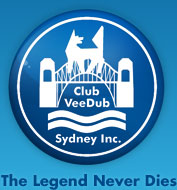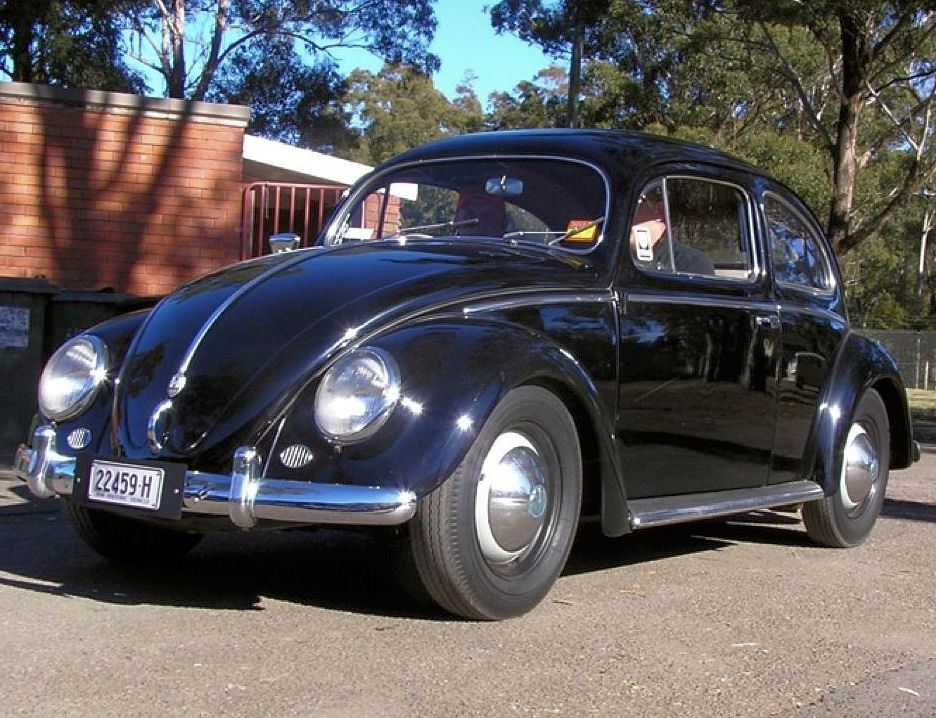Historic Registration
Club Veedub Sydney Historic Vehicle Policy
If you are a Club VW member owning a VW that is more than 30 years old and you don’t use it much, you can register your classic vehicle on Historic Registration that can allow you to use your vintage VW on club-sanctioned events and for personal use at a vast saving on normal registration.
The 'traditional' rules for Club VW Historic Rego are below. In essence, you must have been an active club member for 12 months before you apply, andyour VW must be stock-standard (period accessories - those the same age as the car - are allowed). In 2015, the RMS introduced a new 'log book' scheme, in which our club is participating. This is also outlined here.
All queries on Historic Rego should be directed to the Vintage Regstrar, or come along to a monthly meeting.
RMS Classic Vehicle Logbook Trial
Club VeeDub Sydney is participating in the Classic Vehicle Log Book Trial, developed in 2015 by Transport for NSW and Roads and Maritime Services.
The log book trial will allow classic vehicles to be used for 60 days of general use (ie maintenance and personal use) each year, outside of or in addition to club organised events. Each day’s use must be recorded in a log book issued at a registry or service centre.
The log book trial will operate for two years, with an evaluation to be completed during this period as part of Roads and Maritime’s review of the overall Conditional Registration Scheme.
Staged implementation
The log book trial has two stages:
Stage 1 - From 1 October 2015, vehicles that are in, or eligible to be in, the existing Historic Vehicle Scheme can be part of the log book trial. The registered operator must be a member of a Roads and Maritime recognised historic vehicle club that is participating in the log book trial.
Stage 2 - In early 2016, a Modified Classic Vehicle Scheme is planned for introduction. These vehicles will be eligible for conditional registration and can be included in the log book trial. For more details, see What is the proposed Modified Classic Vehicle Scheme?
The current HCRS has far more legal status and rights with the benefits of less work and costs for the clubs involved. The vehicle owner enters an agreement with the RMS, in much the same way as a conventional registration. The club provides proof that the owner and his/her vehicle comply with the regulations and the club or clubs create the events, or authorisations, whereby the vehicle may be used on the public road.
Please refer to the RMS Classic Vehicle Log Book trial and read it in conjunction with the rules of both the CMC and Club Vee Dub Sydney, below.
Club Veedub Sydney Rules for Historic Registration
Last Updated January 2016 - These rules and regulations supersede all previous versions.
Club Veedub Sydney is a well-established club, with genuine intentions regarding the organising of events for members to enjoy their historic Volkswagens. Club Veedub Sydney is incorporated under the NSW Incorporated Associations laws, which are administered by the Department of Fair Trading. Club Veedub Sydney has adequate Public Liability Insurance cover. Club Veedub Sydney is recognised and authorised by the RMS to apply for and administer Historic Registration on behalf if its members.
Club Veedub Sydney is also a member of the Council of Motor Clubs NSW, and therefore enjoys the benefits of a much larger historical car member base, as well as the CMC's direct connection with the RMS's administration of the HCRS in NSW. Before considering Historic Registration, you should read the CMC's rules:
Historic Registration is one of the many benefits of being a member of Club Veedub Sydney, but please remember it is a privilege, not a right, to be granted Historic Plates.We expect Historic Plate holders to be active members of the club, be known to the committee and attend a minimum number of club functions per year. Club Veedub Sydney will only issue Historic Registration to Volkswagen and Audi vehicles.
DO NOT CONSIDER THIS AS JUST “CHEAP” REGO. It is there for genuine enthusiasts who have other vehicles for everyday transport and wish to enjoy their ‘classic’ VW with like-minded club members.
To apply for and use Historic Registration through Club Veedub Sydney, you must observe the following rules.
Eligibility
1. You must be a resident of NSW, as is the case with normal registration.
2. You must have been a financial member of Club Vee Dub Sydney for a period of 12 months before applying for Historic Registration, and be personally known to the Club on a general level. Attendance at general meetings on a regular basis is the usual guideline, but attendance at normal club events is also encouraged.
3. Your VW must be 30 years old or older. The exact month of manufacture is not critical; it is only the year appearing on the compliance plate or indicated by the chassis number.
4. Your VW should be as close to original as possible with no alterations except for safety features such as seat belts and turn indicators, or period accessories and options.
- Period options are allowed, which means that any options and accessories available for your VW, when it was made, can be fitted. This includes modern reproductions of Historic parts.
- Consumables such as modern tyres, batteries and brake linings are allowed, and so are engine modifications to allow lead-free running.
- Genuine Volkswagen parts from newer models, fitted in the interests of safety such as brakes or suspension parts, may also be accepted at the discretion of the Club.
5. In all cases Club Vee Dub Sydney is the sole arbiter on whether your VW is suitable for Historic Registration through this club. If you have any doubts or questions, please contact the Historic Registrar.
Vehicle Usage
6. Historic vehicles shall only be used for club recognised events, except as set out in the “Servicing of Vehicles” Section below.
7. Club recognised events shall be:
a.
Events as set out on the club events calendar, published in Zeitschrift and in the
Events Calendar page on this website.
b. Events conducted by affiliated car clubs to which an official written invitation has been received by the club.
c. Events which the club gives permission to attend.
8. An event is defined as from your home or place of garaging, directly to the start of the event. Complete the event, and then directly home again.
Servicing of Vehicles
9. All movements of Historically Registered vehicles are to be recorded in an official log book, or movement register held by the Club Registrar. Journeys necessary for refuelling or servicing of vehicles may be made up to 8 km from the notified garaging place of the said vehicle by the shortest possible route, and are permitted at any time, but the movement of the vehicle MUST be recorded in a log book and kept within the car.
10. Longer runs (more than 8 km) necessary for the servicing of vehicles may only be made after receiving permission from the Historic Registrar, or in their absence from the President, Secretary or Treasurer. This permission must be properly recorded in the Club Records by the person approving the movement with full details of time, place and reason. Service runs for road testing a vehicle after extensive work must not exceed 16 km radius of the point of garaging and be recorded in the vehicles log book.
Responsibility of Club Members
11. Initial enquiries should be directed to the Club Registrar for the vehicle's suitability in establishing Historic Registration. Individual approaches are then required to the Roads and Maritime Services (RMS) for establishing the Historic registration and renewals.
12. Historic number plates are issued to a member of the club by the RMS and are not transferable either to another vehicle or person in the event of the vehicle being sold.
13. All movements of the vehicle are to be recorded by the holder of the Historic Registration in a personal log book kept in the vehicle at all times.
14. Registration plates must be immediately returned to the Roads and Maritime Services:
a. In the event of the sale of the vehicle on which they are issued or upon the member’s resignation from the Club;
b. Upon the member’s failure to remain a financial member within the meaning of the Constitution of the Club or on failure to pay any levy that may be constitutionally approved by a duly constituted Club meeting;
c. If the Club Registrar or Committee consider the vehicle has been made unsafe or altered after it has been inspected by an Authorised Motor Vehicle Inspection Station as set out in Part 5 of this document
d. At the directive of a Club Committee decision.
15. Historic Registration is granted in the belief that the members’ prime intended use is for club outings. The committee retains the right to reconsider eligibility for issue or renewal should this cease to be the case or if the vehicle does not attend Club outings during the year without good cause.
16. Of these, you are required to attend at least three (3) Club Vee Dub events per year, which will be logged with the Historic Registrar. If your VW becomes undriveable for any reason, you should contact the Historic Registrar.
17. A current copy of the club calendar (available within the club magazine or website) should be carried in your VW at all times. This will provide proof of the Club-sanctioned event you are attending, if required, such as if pulled over by the Police or RMS.
Annual Vehicle Inspection
18. All vehicles holding an Historic Plate MUST undergo an annual inspection by an Authorised Motor Vehicle Inspection Station and obtain a pink or blue slip for renewal or establishment of Historic Registration. Unregistered vehicles must be trailered to and from the inspection.
19.
The applicant will pay all fees to the Authorised Motor Vehicle Inspection Station and processing fees to the RMS on commencement or renewal of Historic registration. The
Historic Vehicle Declaration Form (RMS website) must be authorised by the Club Plates Registrar, President, Admin Officer or Treasurer (preferably at a club meeting) after financial membership and membership standing is verified. It must be returned to the RMS with the necessary application forms and inspection reports in order to establish or renew registration.
20. Club membership must be current on or before the annual registration date.
21. Chassis, serial, body and engine numbers will form part of the identification of a Historic vehicle. Any change must be notified in writing to the RMS and the Club’s Plate Registrar.
Club's Responsibility
22. The committee will appoint a Historic Club Plates Registrar whose responsibility it is to administer the Historic plate scheme for the Club and its members. He shall review new applications, review existing holders, and receive and record the movements of all club vehicles holding Historic registration in the Club Movements Log. He shall report on the Club's Historic scheme at the Club meetings.
Insurance Requirements
23. A minimum insurance cover of Third Party Property Insurance is required.
24. As part of the RMS Historic registration fees a Compulsory Third Party Insurance (CTP) is issued under the Motor Accident Compensation ACT. This payment is made to QBE Insurance Australia and is collected by the RMS on behalf of QBE when establishing Historic registration annually.
HCRS is a privilege granted to the classic car movement. Both Club Veedub Sydney and the CMC are vigilant in making sure no one abuses the system, and puts our access to it at risk. The network of tens-of-thousands of club members is known for its ability to notify the CMC of anomalies, who are then able to stop any incorrect activities either from within the club movement, or if necessary with the assistence of the RMS and Police.

